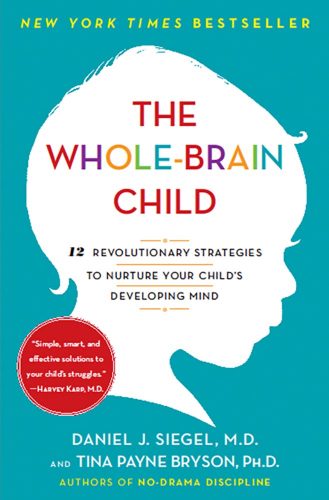
Our awesome team member, Elizabeth Scott, read three books by Dr. Daniel Siegel and Dr. Tina Payne Bryson and has shared her thoughts on each book! We highly recommend these books for parents, caregivers and adults working with children. We hope you enjoy and learn from these books as much as our team has!
Whole Brain Child
I found this book to be both fascinating and helpful. I learned a lot more about the different parts of the brain and how they impact children’s behavior and overall development. The book broke down how the left hemisphere of the brain rules logic while the right side of the brain rules emotion. It’s important for children to find a balance between using these different parts of their mind. I also learned about the idea of the “upstairs” and “downstairs” brain and how children’s upstairs brains are not fully formed until they reach their 20’s. Parents often react to the downstairs brain when it is important to nurture the upstairs brain through connection and communication. The whole brain child, if appropriately encouraged, is explorative and creative in life and is able to develop his or her inner self. Meanwhile, the “no brain” child is reactive and fearful. Caregivers need to harness the tools necessary to encourage the whole brain child in order to promote healthy overall development of self and mind.
No-Drama Discipline
The underlying theme of this book is all about connection between caregivers and children. I love the idea that the root of discipline breaks down to learning rather than punishment. I learned that it’s vital to connect with children to shift from “reactivity to receptivity”. To me this means that children are able to embrace the “why” of a given limit enforced by a parent instead of receiving redirection without a rationale. The reason behind a child’s behavior is so important to address because it helps them advocate for themselves and develop their own voice.
I also enjoyed learning about how caregivers are encouraged to take a step back from overtalking to their children when different issues arise. When a child is in need of redirecting, depending on their developmental stage they will likely tune you out if you overly explain your reasons for limiting screen time or demanding an earlier bedtime. It’s also so necessary to ensure that children are calm before any kind of redirection takes place. Consistency yet not rigidity as a caregiver ensures that you can take a realistic approach to everyday “discipline” situations that arise.
The Yes Brain
This book continues the theme of connection that is emphasized in No-Drama Discipline. I love how the authors discuss the power of free play and how this has become a lost art in our modern culture and society. The “Yes Brain” underlines a child’s ability to have an inner world and play is one crucial way to accomplish this. It is hard to measure a child’s imagination but finding a balance of different types of brain activity will support the Yes Brain. I also enjoyed the book’s discussion of Growth Mindset and the power of yet. This consistently promotes children’s resiliency and encourages them to take risks in order to grow internal strength and flexibility.
I love how this book provides concrete suggestions for developing a Yes Brain. Children need enough sleep, for example, in order to positively function. They also discuss that parents serve what the authors refer to as a “healthy mind platter” in which there are different times of brain work, from down time to focus time. It’s also crucial to balance the family’s schedule so that children have a healthy balance of activity and that their inner world/imagination is being nourished. I like the strategy of the “4 S’s” to provide to children: Safe, Seen, Soothed, and Secure.
